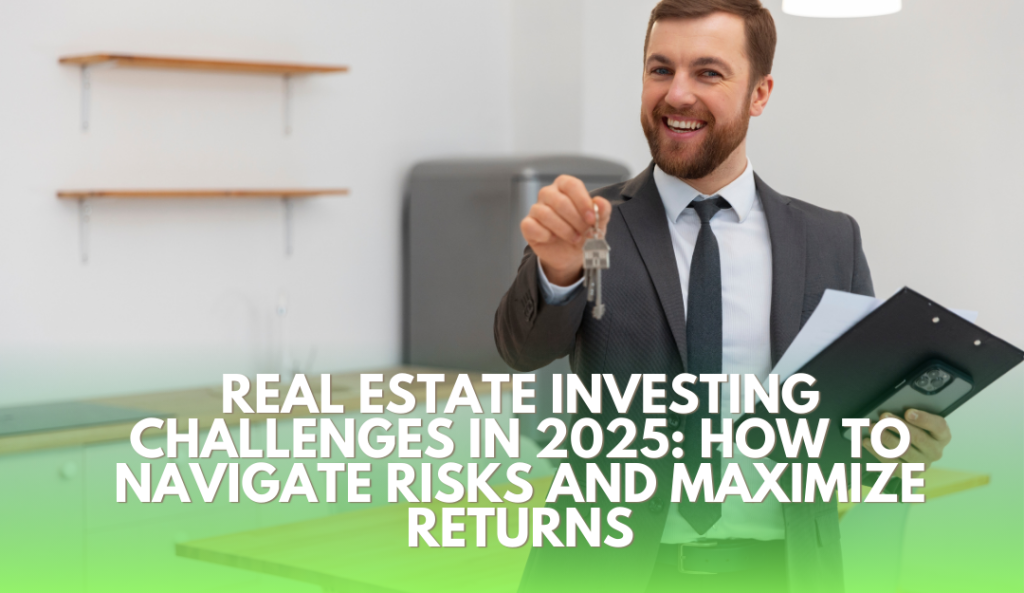Introduction: The 2025 Real Estate Landscape
Real estate continues to be a powerful wealth-building tool, but 2025 presents new challenges—from rising interest rates to AI-driven market disruptions. As an experienced real estate professional, Melina Abalkhad understands that investors need to adapt to stay ahead. Whether you’re a first-time buyer or a seasoned investor, recognizing these challenges and implementing smart strategies is crucial. This guide, curated by Melina Abalkhad, highlights the most pressing obstacles in 2025 and provides data-driven solutions to ensure success.
1. Sky-High Financing Costs
The Challenge

Interest rates in 2025 have surged, creating financial hurdles for investors:
- Higher Mortgage Rates: The 30-year fixed mortgage rate now averages 8.2%, significantly increasing monthly payments compared to previous years.
- Stricter Lending Requirements: Banks demand a minimum credit score of 720 (vs. 680 in 2022) for investment property loans.
Solutions from Melina Abalkhad
- Seller Financing: Negotiating directly with sellers can bypass traditional lenders. A creative approach, like a 10% down payment with a 5-year balloon term, can make deals work.
- Portfolio Loans: Investors with multiple properties can benefit from specialized loan products from regional banks.
- HELOCs: Utilizing home equity at a lower interest rate (6.8% APR) can help finance renovations or new acquisitions.
2. Market Volatility and Tech Disruption
The Challenge

AI-driven real estate trends are reshaping the market:
- Automated Valuations: AI-based valuation models, like Zillow’s, are 98% accurate, reducing negotiation power for individual investors.
- iBuyer Influence: Companies like Opendoor now control 15% of U.S. home sales, outbidding traditional buyers.
Solutions from Melina Abalkhad
- Invest in Niche Markets: Multi-family units, historic homes, and commercial properties remain less affected by iBuyers.
- Leverage Predictive Analytics: Tools like HouseCanary provide insights into market trends 12–24 months in advance.
- Use Blockchain for Transactions: Platforms like Propy streamline the buying process with faster, fee-free transactions.
3. Climate Risks and Rising Insurance Costs
The Challenge
Climate-related issues now add $23 billion annually to U.S. property losses:
- Flood Zones Expanding: 40% more homes face flood risks compared to 2020.
- Skyrocketing Insurance Costs: Florida saw a 35% rise in premiums in 2024, forcing some insurers to exit the market.
Solutions from Melina Abalkhad
- Target Climate-Resilient Markets: Cities like Minneapolis (low flood risk) and Denver (minimal wildfire risk) offer safer investments.
- Invest in Green Upgrades: Solar panels not only cut energy costs but also qualify for a 30% tax credit.
- Consider Parametric Insurance: Blockchain-based insurance policies like Etherisc offer instant payouts for predefined climate events.
4. Tenant Management and Rent Defaults
The Challenge

- Remote Work Shift: With 28% of employees working remotely, demand for urban rentals has decreased.
- Higher Rent Defaults: 12% of tenants are missing rent payments in 2025 (compared to 8% in 2022).
Solutions from Melina Abalkhad
- AI-Powered Tenant Screening: Tools like TurboTenant analyze financial history and social data to predict payment reliability.
- Mid-Term Rentals: Platforms like Furnished Finder cater to remote workers with flexible leasing terms.
- Rent Guarantee Insurance: Companies like The Guarantors cover up to $100,000 annually in missed rent payments.
5. Regulatory Challenges and Legal Restrictions
The Challenge
- Short-Term Rental Bans: Cities like New York and Barcelona are enforcing strict regulations, imposing fines of up to $5,000 per day.
- Rent Control Laws: Twelve states now cap annual rent increases at 4%.
Solutions from Melina Abalkhad
- Pivot to Mid-Term Rentals: Leasing to traveling nurses or corporate clients can bypass short-term rental bans.
- Invest in Opportunity Zones: These federally designated areas offer tax incentives and exemptions from rent control laws.
- Use Legal Compliance Platforms: RentRedi automates compliance with changing rental laws.
6. Liquidity and Exit Strategies
The Challenge
- Slower Property Sales: The average time to sell a property has increased to 85 days, up from 45 days in 2021.
- Defeasance Fees: Paying off commercial mortgages early can incur penalties of 3-5% of the loan balance.
for more visit :
Solutions from Melina Abalkhad
- Diversify with REITs: Allocating 20% of a portfolio to liquid assets like industrial REITs can provide stability.
- Explore Tokenization: Fractional property ownership through platforms like RealT enables quicker liquidity.
- Offer Lease-to-Own Agreements: This strategy attracts buyers by allowing rent payments to count toward future ownership.
2025 Pro Tips for Beginners from Melina Abalkhad
- Start with House Hacking: Buying a triplex and living in one unit while renting the others can save investors $1,500+/month.
- Leverage AI Tools: Software like Zilculator can analyze cash flow, while Roofstock provides turnkey investment opportunities.
- Global Diversification: Programs like Portugal’s Golden Visa allow foreign investors to gain EU residency with a €350k+ investment.
FAQs
Q: Is real estate still a good investment in 2025?
A: Absolutely! Investors should focus on recession-proof niches like healthcare facilities and affordable housing.
Q: How much do I need to start investing?
A: You can begin with as little as $100 through REITs or $50,000 for a duplex down payment.
Q: What’s the safest real estate investment?
A: Single-tenant net-leased properties (e.g., Walgreens) with 10+ year leases offer stable returns.
Conclusion: Build a Future-Proof Portfolio
Despite the evolving challenges, 2025 presents incredible opportunities for strategic investors. By staying ahead of financing trends, leveraging AI, and targeting climate-resilient markets, you can navigate risks and maximize returns. Melina Abalkhad encourages investors to remain adaptable and well-informed, turning market shifts into advantages.

